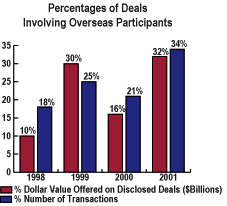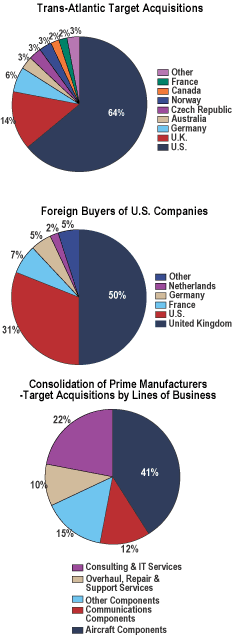MARKET WATCH
The globalization of commerce, technology and finance has begun to affect the aerospace, defense and public-sector markets. The relaxation of many of the impediments to more open government markets is gaining momentum in the United States, as well as in the United Kingdom and European markets. This trend is likely to continue and, more probably, to expand in the years ahead,
The globalization of commerce, technology and finance has begun to affect the aerospace, defense and public-sector markets. The relaxation of many of the impediments to more open government markets is gaining momentum in the United States, as well as in the United Kingdom and European markets. This trend is likely to continue and, more probably, to expand in the years ahead.
The implications for U.S. and foreign tier-one prime contractors are abundantly clear to shareholders and executives alike. However, management teams and shareholders of tier-two and tier-three companies, in many instances, have not sorted out this issue relative to their strategies.

Arguably, the impacts of globalization, on balance, will be positive. From an historical perspective, defense and government entities within the NATO alliance have focused procurement activities on domestic companies at the expense of foreign entities. Language, culture, national security, military-specification requirements, among other factors, had driven and sustained this mindset ? until the late 1990s.
Things change. Owners of U.S.-based companies must understand the international picture to establish strategic direction, determine acquisition and alliance initiatives and assess shareholder liquidity alternatives.
Let's examine the facts and circumstances that bear upon these trends, then consider how U.S.-based companies will be affected.
The relative strength of the U.S. economy over the last six to eight years, coupled with an open trading orientation by the federal government, enticed many foreign companies to seek a larger slice of U.S. markets. The internationalization of technology continues as major competitors in most segments require global market opportunity to drive down unit production costs, grow brand awareness, fund research and developments costs and establish their technology as the de-facto standard.

The array of cutting-edge commercial technologies provided the impetus for governments and defense procurement officials to seek commercial systems solutions rather than specially engineered systems. International capital flows have increased as capital markets increasingly connect investors and companies across borders.
Research and development expenditures directed at advancing applied technology are prevalent in public and private sectors in the United States, Europe and the Pacific Rim. Distinguished competitors in communications, computer hardware and software, opto-electronics, data security and many other disciplines have emerged around the globe.
At the same time, critical shortages of technology workers in many markets are pushing technology users and providers to rethink business processes and, often, look to outsourcing. And, of course, the Internet has raised global connectivity to a level not foreseen a decade ago.
The impacts of these trends are still unfolding, particularly in aerospace, defense and government tech services markets. We anticipate more significant competition from non-U.S. aerospace and defense primes and more opportunities for shareholders in mid-sized U.S. companies to gain liquidity at favorable prices as foreign defense firms pursue domestic market opportunities here.
Very selectively, the overseas markets may provide sales expansion potential for mid-sized U.S. companies with unique depth in specialty systems.
Major U.S. primes ? Lockheed Martin Corp., Raytheon Co., Northrop Grumman Corp. and General Dynamics Corp., among others ? are increasingly involved in overseas markets, often through joint venture arrangements or other forms of corporate alliance. However, the newly formed, large European companies ? BAE Systems Plc, EADS and Thales, and others ? have much longer histories of dealing in non-U.S. defense markets and have used a variety of corporate alliance arrangements to gain access to small to mid-sized defense markets around the world.
Evidence of the international trends is presented on the right. The proportion of aerospace and defense deals involving overseas participants in 2001 (34 percent) is nearly double the 1998 level (18 percent). On a deal value basis, the proportion has tripled over this period. Nearly two-thirds of the acquisition targets (64 percent) are U.S. companies, reflecting both the international tendencies of European companies, as well as the strength of U.S. defense markets and the more benign attitude of government toward foreign ownership of U.S. contractors.
A profile of acquirers in these trans-Atlantic deals reveals the aggressive approach of U.K. buyers, comprising half of the acquirers, relative to the 31 percent component for the U.S.-based companies. The clear majority of trans-Atlantic transactions (approximately 80 percent) involve U.S. or U.K. companies on one side or the other.
A profile of the transaction activity by lines of business shows the dominance of the aerospace and defense products companies as targets in 68 percent of the deals vs. 32 percent for consulting, IT services and support services (government tech services component).
Absent changes in the attitude of government and defense buyers toward a more protective and protectionist stance, the importance of international markets in aerospace and defense and government tech services will continue. Understanding these international markets is essential for growing tier-one and tier-two companies in both product and services markets.
Jerry Grossman is managing director at Houlihan Lokey Howard & Zukin in McLean, Va.